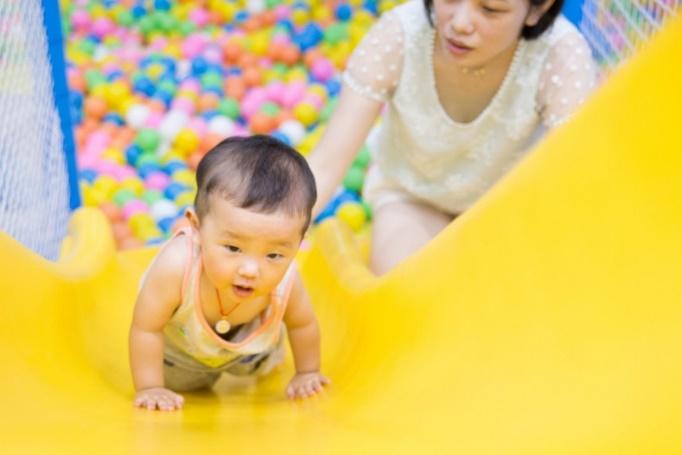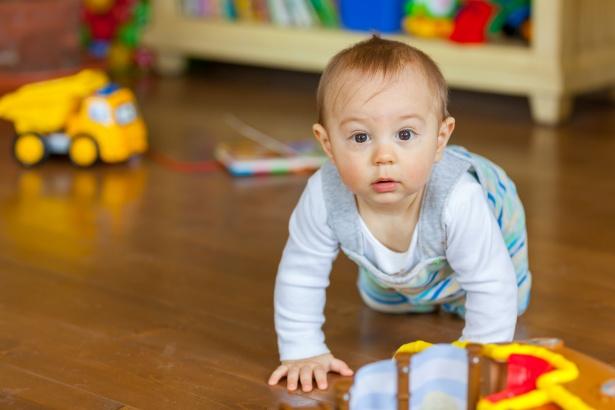6.4 Attachment Theory and Research
The twentieth century became a time of scientific interest and inquiry into child development. The formation of attachments in infancy has been the subject of considerable research. Attachments have been viewed as foundations for future relationships, self-concept, and identity. Below we will highlight theories and research studies of attachment.

Figure 6.1. The formation of attachment in action as a father snuggles a newborn.
6.4.1 The Harlows’ Studies
In one classic study, Wisconsin University psychologists Harry and Margaret Harlow investigated the responses of young rhesus monkeys to explore if breastfeeding was the most important factor to attachment.
The infant monkeys were separated from their biological mothers, and two surrogate mothers were introduced to their cages. The first mother (the wire mother) consisted of a round wooden head, a mesh of cold metal wires, and a milk bottle from which the baby monkey could drink. The second mother was a foam-rubber form wrapped in a heated terry-cloth blanket. The infant monkeys went to the wire mother for food, but they overwhelmingly preferred and spent significantly more time with the warm terry-cloth mother (Figure 6.2). The warm terry-cloth mother provided no food but did provide comfort (Harlow, 1958).

Figure 6.2. A rhesus monkey sucking their thumb.
The infant’s need for physical closeness and touching is referred to as contact comfort. Contact comfort is believed to be the foundation for attachment. The Harlows’ studies confirmed that babies have social and physical needs. Both monkeys and human babies need a secure base that allows them to feel safe. From this base, they can gain the confidence they need to venture out and explore their worlds.
6.4.2 Bowlby’s Theory
Building on the work of Harlow and others, John Bowlby developed the concept of attachment theory. He defined attachment as the affectional bond or tie that an infant forms with their mother (Bowlby, 1969). An infant must form this bond with a primary caregiver in order to have normal social and emotional development. In addition, Bowlby proposed that this attachment bond is very powerful and continues throughout life. He used the concept of a secure base to define a healthy attachment between parent and child (Bowlby, 1982). A secure base is a parental presence that gives the child a sense of safety as the child explores the surroundings.

Figure 6.3. A mother offers a secure base as her infant plays on a slide.
Bowlby said that two things are needed for a healthy attachment: The caregiver must be responsive to the child’s physical, social, and emotional needs, and the caregiver and child must engage in mutually enjoyable interactions (Bowlby, 1969). Additionally, Bowlby observed that infants would go to extraordinary lengths to prevent separation from their parents, such as crying, refusing to be comforted, and waiting for the caregiver to return.
Bowlby also observed that these same expressions were common to many other mammals and consequently argued that these negative responses to separation serve an evolutionary function. Because mammalian infants cannot feed or protect themselves, they are dependent upon the care and protection of adults for survival. Thus, those infants who were able to maintain proximity to an attachment figure were more likely to survive and reproduce.
6.4.3 Mary Ainsworth and the Strange Situation
Developmental psychologist Mary Ainsworth, a student of John Bowlby, continued studying the development of attachment in infants. Ainsworth and her colleagues created a laboratory test that measured an infant’s attachment to his or her parents. The test is called The Strange Situation because it is conducted in a context that is unfamiliar to the child and, therefore likely to heighten the child’s need for his or her parent (Ainsworth, 1979).

Figure 6.4. An infant crawling on the floor with toys around as done in the Strange Situation.
During the procedure, which lasts about 20 minutes, the parent and the infant are first left alone while the infant explores the room full of toys. Then a strange adult enters the room and talks for a minute to the parent, after which the parent leaves the room. The stranger stays with the infant for a few minutes, and then the parent again enters, and the stranger leaves the room. During the entire session, a video camera records the child’s behaviors, which are later coded by the research team. The investigators were especially interested in how the child responded to the caregiver leaving and returning to the room, referred to as the “reunion.”
On the basis of their behaviors, the children are categorized into one of four groups where each group reflects a different kind of attachment relationship with the caregiver. One style is secure, and the other three styles are referred to as insecure.
- Secure attachment refers to a bond in which a child feels secure with their caregivers and uses them as a base from which to explore their environment. A child with a secure attachment style usually explores freely while the caregiver is present and may engage with the stranger. The child will typically play with the toys and bring one to the caregiver to show and describe from time to time. The child may be upset when the caregiver departs but is also happy to see the caregiver return.
- Ambivalent attachment refers to a bond in which the child seeks closeness to their caregivers and is hesitant to explore the environment. A child with an ambivalent attachment style (sometimes called resistant or anxious-ambivalent) is wary about the situation in general, particularly the stranger, and stays close or even clings to the caregiver rather than exploring the toys. When the caregiver leaves, the child is extremely distressed and ambivalent when the caregiver returns. The child may rush to the caregiver but then fails to be comforted when picked up. The child may still be angry and even resist attempts to be soothed.
- Avoidant attachment refers to a bond in which the child avoids or is dismissive to their caregivers and may not explore the environment. A child with an avoidant attachment style will avoid or ignore the mother, showing little emotion when the mother departs or returns. The child may run away from the mother when she approaches. The child will not explore very much, regardless of who is there, and the stranger will not be treated much differently from the mother.
- Disorganized attachment refers to a bond in which a child demonstrates an inconsistent relationship to their caregiver and how they interact with the environment. A child with a disorganized (or disoriented) attachment style seems to have a confused or apprehensive way of coping with the stress of the strange situation. The child may cry during the separation but avoid the mother when she returns, or the child may approach the mother but then freeze or fall to the floor.
How common are the attachment styles among children in the United States? It is estimated that about 65% of children in the United States are securely attached (Moullin et al., 2014). 20% exhibit avoidant styles, and 10% to 15% are ambivalent. Another 5% to 10% of children may be characterized as disorganized.
Some cultural differences in attachment styles have been found (Rothbaum et al., 2010). For example, German parents value independence, and Japanese mothers are typically by their children’s sides. As a result, the rate of insecure-avoidant attachments is higher in Germany, and insecure-resistant attachments are higher in Japan. These differences reflect cultural variation rather than true insecurity, however (van Ijzendoorn & Sagi, 1999). Overall, secure attachment is the most common type of attachment seen in every culture studied thus far (Thompson, 2006).
Most developmental psychologists argue that a child becomes securely attached when there is consistent contact from one or more caregivers who meet the physical and emotional needs of the child in a responsive and appropriate manner. However, even in cultures where mothers do not talk, cuddle, and play with their infants, secure attachments can develop (LeVine et. al., 1994).
Severe deprivation of parental attachment can lead to serious problems. According to studies of children who have not been given warm, nurturing care, they may show developmental delays, failure to thrive, and attachment disorders (Bowlby, 1982). Non-organic failure to thrive is the diagnosis for an infant who does not grow, develop, or gain weight on schedule and there is no known medical explanation for this failure. Poverty, neglect, inconsistent parenting, and severe family dysfunction are correlated with non-organic failure to thrive. In addition, postpartum depression can cause even a well-intentioned mother to neglect her infant.
Children who experience social neglect or deprivation, repeatedly change primary caregivers that limit opportunities to form stable attachments or are reared in unusual settings (such as institutions) can have difficulty forming attachments. According to the Diagnostic and Statistical Manual of Mental Disorders, 5th edition, Text Revision (American Psychiatric Association, 2022), reactive attachment disorder refers to a diagnosable mental disorder characterized by inappropriate attachment behaviors such as being inhibited and withdrawn, demonstrating minimal social and emotional responsiveness to others, limited positive affect, and developmental delays, especially in cognitive and language domains.
Fortunately, the majority of severely neglected children do not develop reactive attachment disorder. This disorder occurs in less than 10% of children (Irfan et al., 2022). The quality of the caregiving environment after serious neglect affects the development of this disorder. Being able to overcome challenges and successfully adapt is known as resiliency. Even young children can exhibit strong resiliency to harsh circumstances. Resiliency can be attributed to certain personality factors, such as an easy-going temperament. Receiving support from others also leads to resiliency.
6.4.4 Licenses and Attributions for Attachment Theory and Research
“Attachment Theory and Research” from Lifespan Development – A Psychological Perspective by Martha Lally and Suzanne Valentine-French is licensed under CC BY 4.0 with minor edits.
Figure 6.1. Image by Andres and Antoinette Ricardo used with permission.
Figure 6.2. “Baby Monkey at Kaew Elephant Camp” by splotter_nl is licensed under CC BY 2.0.
Figure 6.3. Image is licensed under CC0 Public Domain.
Figure 6.4. “Toddler In Playroom” is licensed under CC0 Public Domain.
